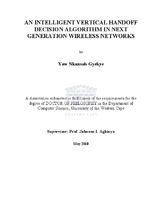| dc.contributor.advisor | Agbinya, Johnson I. | |
| dc.contributor.author | Gyekye, Yaw Nkansah | |
| dc.date.accessioned | 2014-07-04T11:50:53Z | |
| dc.date.available | 2014-07-04T11:50:53Z | |
| dc.date.issued | 2010 | |
| dc.identifier.uri | http://hdl.handle.net/11394/3449 | |
| dc.description | Philosophiae Doctor - PhD | en_US |
| dc.description.abstract | Seamless mobility is the missing ingredient needed to address the inefficient
communication problems faced by the field workforces of service companies that are using field workforce automation solutions to streamline and optimise the operations of their field workforces in an increasingly competitive market place. The key enabling function for achieving seamless mobility and seamless service continuity is seamless handoffs across heterogeneous wireless access networks. A challenging issue in the multi-service next generation wireless network (NGWN) is to design intelligent and optimal vertical handoff decision algorithms, beyond traditional ones that are based on only signal strength, to determine when to perform a handoff and to provide optimal choice of access network technology among all available access networks for users equipped with multimode mobile terminals. The objective of the thesis research is to design such vertical handoff decision algorithms in order for mobile field workers and other mobile users equipped with contemporary multimode mobile devices to communicate seamlessly in the NGWN. In order to tackle this research objective, we used fuzzy logic and fuzzy inference systems to design a suitable handoff initiation algorithm that can handle imprecision and uncertainties in data and process multiple vertical handoff initiation parameters (criteria); used the fuzzy multiple attributes decision making method and context awareness to design a suitable access network selection function that can handle a tradeoff among many handoff metrics including quality of service requirements (such as network conditions and system performance),
mobile terminal conditions, power requirements, application types, user preferences, and a price model; used genetic algorithms and simulated annealing to optimise the access network selection function in order to dynamically select the optimal available access network for handoff; and we focused in particular on an interesting use case: vertical handoff decision between mobile WiMAX and UMTS access networks. The implementation of our handoff decision algorithm will provide a network selection mechanism to help mobile users select the best wireless access network among all available wireless access networks, that is, one that provides always best connected services to users | en_US |
| dc.language.iso | en | en_US |
| dc.subject | Field workforce | en_US |
| dc.subject | Seamless mobility | en_US |
| dc.subject | Seamless communication | en_US |
| dc.subject | Vertical handoff | en_US |
| dc.subject | Vertical handoff decision | en_US |
| dc.subject | Intelligent and optimal vertical handoff decision algorithm | en_US |
| dc.subject | Next generation wireless network | en_US |
| dc.subject | Multimode mobile terminal | en_US |
| dc.subject | Access network selection | en_US |
| dc.subject | Fuzzy logic | en_US |
| dc.subject | Fuzzy multiple attributes decision making | en_US |
| dc.subject | Mathematical optimization | en_US |
| dc.subject | Genetic algorithm | en_US |
| dc.subject | Simulated annealing | en_US |
| dc.title | An intelligent vertical handoff decision algorithm in next generation wireless networks | en_US |
| dc.type | Thesis | en_US |

